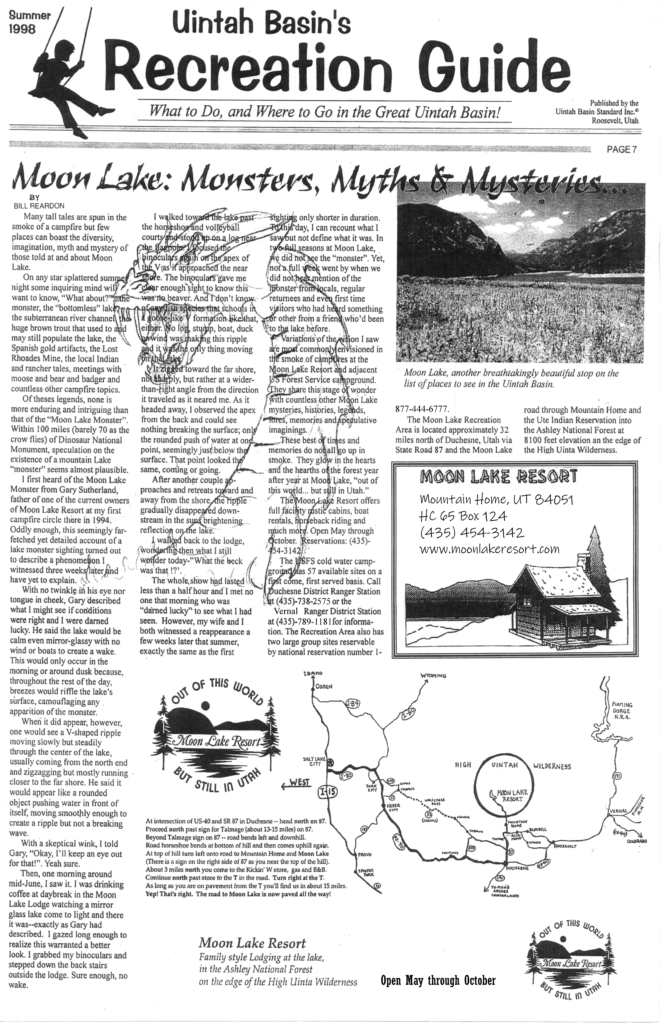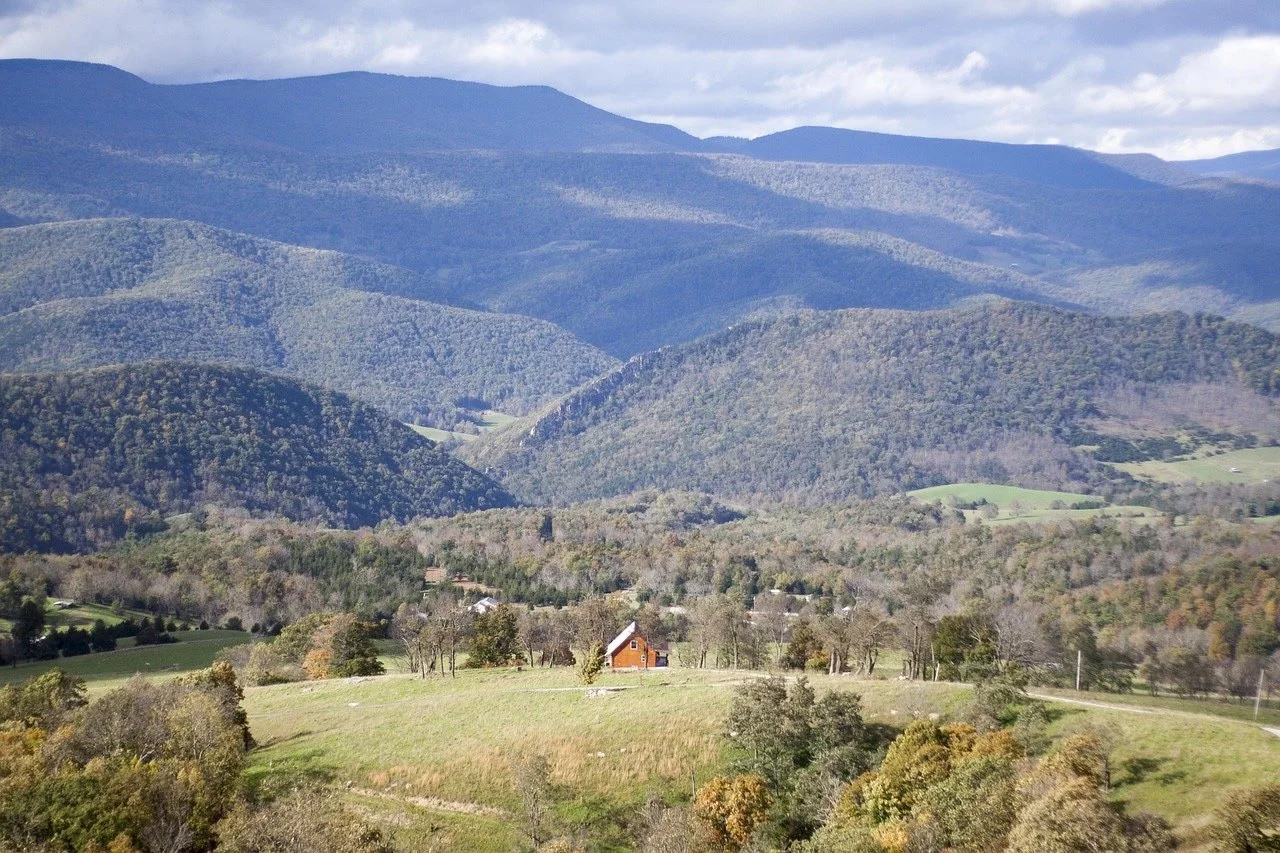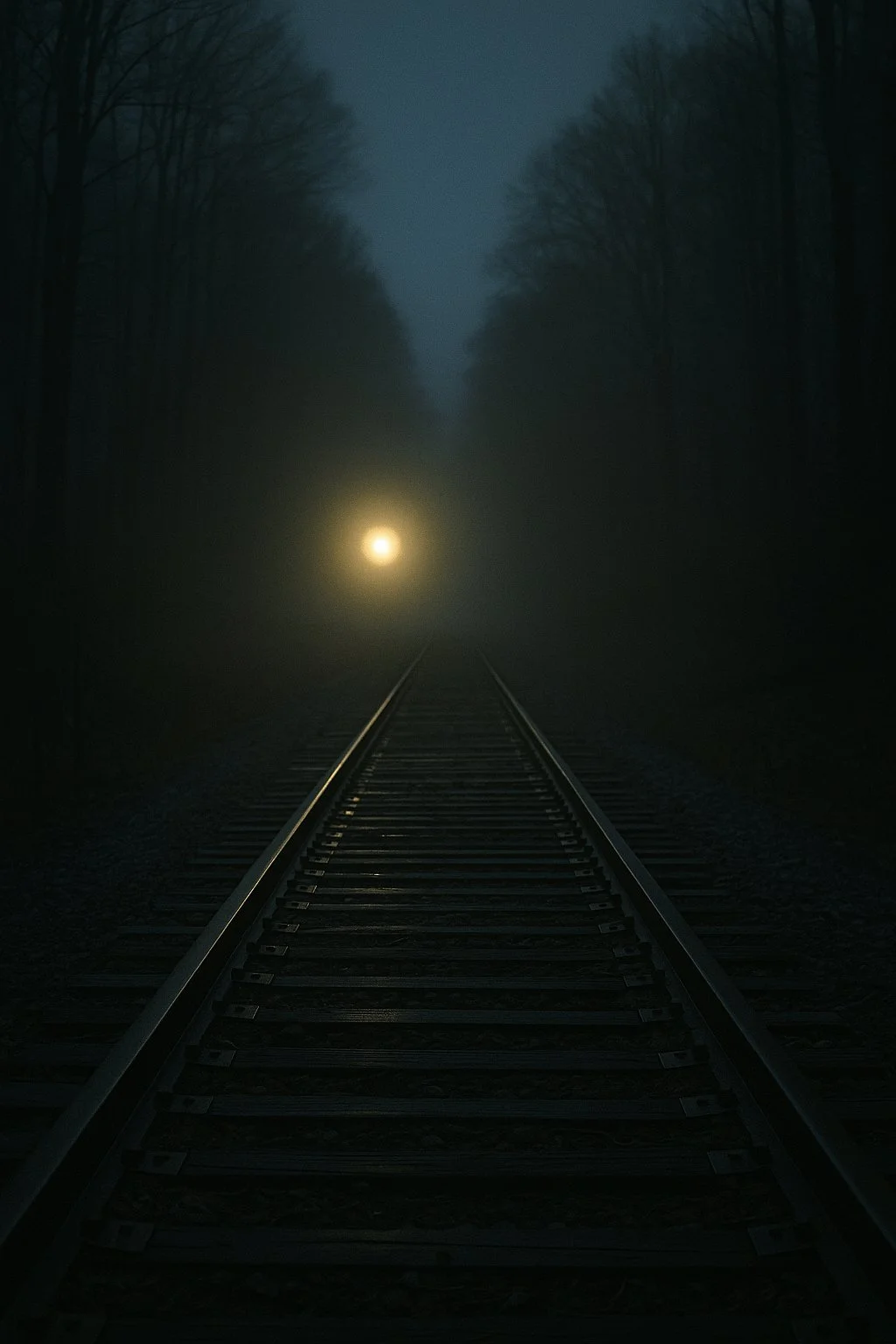BLOG: 8 Accounts of Cryptids, Phantoms, and Paranormal Phenomena in America's Remote Wilderness
The American wilderness holds more than just scenic views—it hides stories that defy explanation. From glowing lights above remote mountains to creatures that prowl the dark edges of campgrounds, real reports of ghostly visitors, vanishing campers, and mysterious cryptids have haunted outdoor explorers for generations. These aren’t just campfire tales—they’re historical accounts backed by eyewitnesses, folklore, and chilling consistency across decades. Here are some of the most unsettling true encounters from deep in the woods.
1. The Beast of the Land Between the Lakes – Tennessee/Kentucky
Image from Wikimedia.
In the dense woodlands of the Land Between the Lakes (LBL) National Recreation Area—spanning parts of Tennessee and Kentucky—a chilling legend persists: the Beast of LBL. Described as a towering, bipedal creature with glowing red eyes, the Beast is said to resemble a cross between a Bigfoot and a werewolf. Over the years, numerous accounts have surfaced, painting a picture of a formidable entity that instills fear in those who encounter it.
One of the earliest and most harrowing accounts dates back to the early 1980s, involving a gas station attendant named Jan Thompson. According to her testimony, during a late-night shift, two police officers—referred to as Officer Bill and Officer Adam—arrived at the station visibly shaken. Officer Adam was so disturbed that he reportedly vomited upon arrival. They recounted an encounter with a massive, shadowy figure lurking just beyond the tree line, accompanied by guttural growls that seemed to emanate from the darkness. Thompson's detailed account has been preserved in various retellings, including a podcast episode by Lyle Russell, which delves into the chilling specifics of that night. (source)
The Beast's physical description is consistent across multiple reports: a creature standing over seven feet tall, with a muscular build, inch-long claws, and eyes that glow a fiery red. Its appearance is often likened to that of a werewolf or "Dogman," a term used in cryptozoology to describe such entities . Witnesses have reported hearing eerie howls echoing through the night and discovering mutilated animal carcasses, fueling speculation about the Beast's existence. (source)
Despite the numerous accounts and investigations, no concrete evidence has been found to confirm the Beast's existence. The U.S. Forest Service has stated that there is no documentation or validated sightings of such a creature within the LBL area . Nevertheless, the legend endures, woven into the fabric of local folklore and continuing to intrigue and terrify those who venture into the depths of the Land Between the Lakes.
Listen to another harrowing dogman encounter in the LBL in Episode 514: Terror In The LBL.
2. The Brown Mountain Lights – North Carolina
In the shadowy expanse of North Carolina's Pisgah National Forest, the Brown Mountain Lights have captivated observers for over a century. These ethereal illuminations—glowing orbs of red, blue, or white—are reported to hover, dart, and sometimes vanish above the ridges of Brown Mountain, particularly on clear, crisp nights following rainfall. Their elusive nature and unpredictable appearances have sparked a blend of scientific inquiry and rich Appalachian folklore. (source)
The earliest documented account of these lights dates back to 1913, when the Charlotte Daily Observer published a report describing unexplained lights rising above the summit. This spurred widespread public interest and prompted the U.S. Geological Survey to investigate. In 1922, geologist George R. Mansfield conducted a detailed study, attributing the phenomena to mundane sources such as train headlights, automobile lights, and brush fires. However, this explanation failed to satisfy many locals and visitors who had witnessed the lights under conditions that ruled out these causes. (source)
Adding to the mystery are tales rooted in Native American legends. Some stories suggest that the lights are the spirits of Cherokee or Catawba warriors who perished in a great battle, their souls eternally searching the mountain for peace. Others speak of a heartbroken woman wandering the mountain with a lantern, seeking her lost lover. (source)
Modern scientific theories have attempted to explain the lights through natural phenomena such as marsh gas emissions, reflections of distant lights, or even piezoelectric effects from quartz-bearing rocks under stress. Yet, none have conclusively accounted for the lights' behavior, leaving the Brown Mountain Lights as one of the enduring enigmas of the Appalachian region. (source)
The allure of the Brown Mountain Lights has permeated popular culture, inspiring songs, books, and television episodes, including an installment of The X-Files. They continue to draw tourists and paranormal enthusiasts to observation points like the Brown Mountain Overlook and Wiseman's View, all hoping to catch a glimpse of the mysterious lights that dance across the mountain's darkened silhouette. (source)
3. The Moon Lake Monster – Utah
Nestled within the Ashley National Forest in northeastern Utah, Moon Lake is renowned for its serene beauty and recreational offerings. Yet, beyond its tranquil surface lies a tapestry of legends and unexplained phenomena that have captivated visitors for generations. (source)
Image from moonlakeresort.com.
Central to these tales is "Moonie," the enigmatic Moon Lake Monster. Described variably as a large, black, bumpy creature resembling a log with scales or a fin, or as a giant serpent, Moonie has been the subject of numerous eyewitness accounts. Sightings often occur during calm, windless conditions in the early morning or evening, when the lake's surface is mirror-like. Witnesses have reported observing V-shaped ripples moving steadily across the water, with no visible source, leading to speculation about a submerged entity beneath the surface. (source)
One notable account comes from Bill Reardon, a former owner of Moon Lake Resort. In 1994, while enjoying a quiet morning, Reardon observed a V-shaped ripple moving across the lake without any apparent cause. Using binoculars, he confirmed the absence of boats, animals, or wind that could explain the disturbance. The phenomenon repeated itself a few weeks later, reinforcing his belief in the presence of an unexplained creature in the lake. (source)
The lore surrounding Moonie is further enriched by indigenous legends. According to local Ute tribal stories, the lake is inhabited by a spirit or creature that should not be disturbed. Some narratives speak of a large hand emerging from the lake to pull a canoe and its occupants beneath the surface, never to be seen again. Such tales have contributed to a longstanding wariness among some Native American communities regarding the lake. (source)
Adding to the mystique is the legend of a ghostly young girl said to haunt the lake's shores. Campers have reported encounters with a soaking wet child, appearing lost and shivering, who vanishes upon approach. Others have heard unexplained splashing sounds or cries near the water at night, further fueling the lake's haunted reputation. (source)
Despite the lack of scientific evidence confirming Moonie's existence, the consistency of eyewitness accounts and the lake's rich tapestry of legends continue to intrigue visitors. Whether viewed as folklore or potential cryptid encounters, Moon Lake remains a focal point for those drawn to the mysteries that lie beneath its placid surface.
4. The Phantom Camper – Summer Camp Lore
In the shadowy lore of summer camps, few tales are as chilling or enduring as that of the "Phantom Camper." This legend, whispered around countless campfires, tells of a young camper who vanished without a trace, leaving behind only the eerie echoes of their presence.
The story often begins with a camper who, after a day filled with typical camp activities, retires to their tent for the night. Sometime during the dark hours, they disappear, their bedroll undisturbed, personal belongings untouched, and no signs of a struggle. Despite exhaustive search efforts by camp staff and authorities, no clues emerge. The camper is simply gone, swallowed by the night.
In the years following the disappearance, campers and counselors report unsettling experiences. Some hear faint whispers outside their tents, hushed giggles, or the soft crunch of footsteps circling their sleeping quarters. Others claim to see fleeting shadows darting between trees or feel an inexplicable chill in the air. These occurrences are invariably attributed to the restless spirit of the missing camper, forever wandering the campgrounds.
The legend serves multiple purposes within the camp community. For some, it's a thrilling tale to share during storytelling sessions, a means to bond over shared goosebumps. For others, it's a cautionary narrative, emphasizing the importance of safety and the buddy system. Regardless of its function, the tale of the Phantom Camper endures, a spectral thread woven into the fabric of camp traditions.
While the origins of the story are murky, its impact is undeniable. The legend has been documented in various collections of campfire stories and continues to be a staple in the repertoire of camp counselors seeking to send shivers down the spines of their charges. Whether viewed as a mere ghost story or a chilling reminder of the unknown, the Phantom Camper remains an indelible part of summer camp folklore.
5. The Catfish Man of Kentucky
In the secluded hollows of Lawrence County, Kentucky, whispers of a peculiar creature known as the "Catfish Man" have circulated for generations. Described as a humanoid entity with fish-like features, particularly a head resembling that of a catfish—complete with wide mouth and barbels—this cryptid is said to inhabit the waterways near Morgan’s Creek. Local lore suggests that the Catfish Man emerges from the depths during the twilight hours, instilling a sense of dread in those who encounter him. (source)
One notable account involves a family of hunters who, while traversing the dense woodlands near the creek, reported a chilling encounter. As they navigated the underbrush, they heard splashing sounds emanating from the waterway. Upon investigation, they claimed to have seen a towering figure, partially submerged, with a grotesque, fish-like visage staring back at them. The creature reportedly emitted a low, guttural sound before disappearing beneath the murky waters. The hunters, seasoned and familiar with the local fauna, were adamant that what they witnessed was neither man nor known animal.
The legend of the Catfish Man has been documented in local history books, preserving the tales passed down through oral traditions. These accounts often serve as cautionary tales, warning children and outsiders of the mysterious being lurking in the waterways. While skeptics attribute sightings to misidentified wildlife or folklore, the consistency of descriptions across different accounts lends an air of credibility to the legend. (source)
Interestingly, the region is known for its sizable catfish population, with anglers frequently reporting catches of impressive specimens. In 2018, during a significant flood event, a man in nearby Bullitt County caught a massive catfish in his front yard, highlighting the prevalence of large catfish in Kentucky's waterways . Such events may have contributed to or reinforced the legend of the Catfish Man, blurring the lines between reality and folklore. (source)
Whether a product of imagination, misidentification, or something more enigmatic, the Catfish Man of Morgan’s Creek remains an enduring figure in Kentucky's rich tapestry of local legends.
6. The Goatman of Maryland
In the dense woods of Prince George's County, Maryland, a chilling legend has persisted for decades: the Goatman. Described as a half-man, half-goat creature, often wielding an axe, the Goatman is said to inhabit the areas around Fletchertown Road in Bowie. The legend gained significant attention in 1971 when a local family's dog, Ginger, was found decapitated near their home. The incident was reported in the Prince George's County News under the headline "Residents Fear Goatman Lives: Dog Found Decapitated in Old Bowie." The article connected the dog's death to sightings of a large, hairy creature walking on its hind legs, reported by the family's daughter and her friends on the night Ginger disappeared. (source)
The origins of the Goatman legend are varied. One popular theory suggests that the creature was once a scientist at the Beltsville Agricultural Research Center who, after a failed experiment involving goats, transformed into the monstrous Goatman. This narrative became so widespread that the USDA issued a statement denying any such experiments or transformations occurred at their facility. (source)
Other accounts trace the legend back to the 1950s, with reports of a hairy, bipedal creature in areas like Forestville and Upper Marlboro. Some believe the Goatman is a vengeful goat herder who went mad after teenagers killed his flock, leading him to seek revenge on unsuspecting passersby. (source)
The Goatman has become an integral part of local folklore, inspiring "Goatman hunts" among teenagers and featuring in various media, including documentaries and horror films. Despite numerous investigations and the passage of time, the legend endures, with occasional reports of sightings and unexplained phenomena in the region. Whether a product of imagination, misidentification, or something more sinister, the Goatman remains one of Maryland's most enduring and eerie legends.-
7. The Whistling Spirits of Appalachia – West Virginia
In the remote hollows of West Virginia, tales abound of eerie whistling sounds echoing through the night, often attributed to restless spirits or "haints." These spectral whistles are not mere figments of imagination but are deeply rooted in Appalachian folklore. The belief is so pervasive that a common adage warns, "If you hear whistling at night, you didn't," implying that acknowledging the sound could invite misfortune. (source)
West Virginia image from Pixabay.
One particularly chilling account comes from a seasoned hiker who ventured into the dense forests near the Monongahela National Forest. As dusk settled, he began to hear a distant, melodic whistle that seemed to mimic a tune he couldn't quite place. Initially dismissing it as another camper or perhaps a bird, he continued setting up his tent. However, as night enveloped the forest, the whistling grew louder and more insistent, circling his campsite. No matter how hard he tried, he couldn't locate the source. The sound was omnipresent, yet elusive. Feeling an overwhelming sense of dread, he decided to abandon his campsite and hike back to his car, guided only by his flashlight. Even as he drove away, the haunting whistle lingered in his ears.
Such stories are not isolated incidents. Many locals and travelers have reported similar experiences, describing the whistle as both alluring and terrifying. Some believe these sounds are the spirits of those who perished in the mountains, forever wandering and warning the living of impending danger. Others think they are malevolent entities, luring victims deeper into the woods. Regardless of the interpretation, the whistling spirits of Appalachia remain one of West Virginia's most enduring and spine-chilling legends.
8. The Maco Light – The Headless Brakeman of North Carolina
In the dense woodlands near Maco Station in Brunswick County, North Carolina, a spectral phenomenon known as the "Maco Light" once captivated locals and travelers alike. First reported in the late 19th century, this mysterious light was described as a glowing orb, often white or bluish, that hovered and moved erratically along a section of the railroad tracks. Witnesses recounted seeing the light swing back and forth, resembling a lantern carried by an unseen hand, before vanishing into the night. (source)
The legend of the Maco Light is intimately tied to the tragic tale of Joe Baldwin, a railroad brakeman in the 1860s. According to local lore, Baldwin was asleep in the caboose of a train when it became detached from the rest of the train. Realizing the imminent danger of an oncoming train, he ran to the rear platform, frantically waving his lantern to warn the engineer. Tragically, his efforts were in vain, and the oncoming train collided with the caboose, decapitating Baldwin. In the aftermath, tales emerged of a ghostly light seen along the tracks, believed to be Baldwin's spirit searching for his lost head.
The Maco Light garnered widespread attention over the years. In 1889, President Grover Cleveland's train reportedly made an unscheduled stop at Maco Station due to sightings of the mysterious light. The phenomenon was so renowned that the Atlantic Coast Line Railroad eventually removed the tracks in 1977, partly due to the persistent tales and the area's reputation. (source)
Despite numerous investigations, the Maco Light was never conclusively explained. Some theories suggested it was caused by swamp gas or reflections from distant lights, but these explanations failed to account for the light's specific behaviors and consistent appearances. Since the removal of the tracks, sightings have dwindled, but the legend endures, a haunting reminder of a bygone era and the mysteries that linger in the Southern night.
From haunted campsites to cryptid-infested forests, these stories reveal that the great outdoors holds more than just natural beauty—it’s also a backdrop for some strange and unsettling encounters with the unexplained. Whether whispered around a campfire or documented in historical archives, these tales continue to intrigue, terrify, and remind us that when night falls in the wilderness, even if we can’t see what’s out there… we may not be alone.




